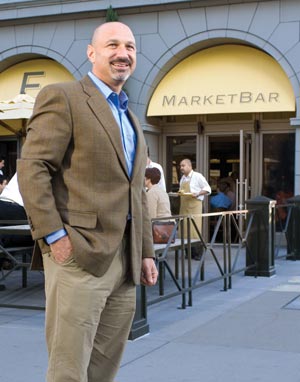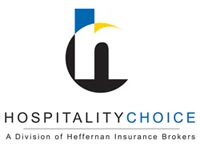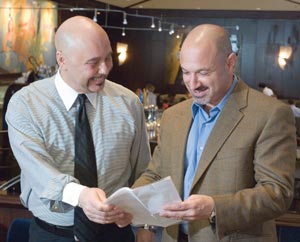Serving up hospitality Hospitality specialty is a natural for Heffernan Group By Sandra Carcione
The San Francisco Bay area is known for its culinary prowess as well as an extensive tourist trade, so a hospitality specialty for a local insurance agency is logical, especially for one that is well known for niche programs. Heffernan Group, a $60 million agency based in Walnut Creek, California, inherited a restaurant and hotel program from its merger partner, Picetti & Williams, in 1997. Since then, the agency has grown the business into a lucrative specialty with more than $2 million in revenues. In addition to its hospitality niche, the agency specializes in contractors, health care, property owners, technology, lawyers, nonprofits, churches, and more. How it all started “The original decision to serve restaurants was definitely location driven,” says Steve Williams, senior vice president, who brought the restaurant program with him to Heffernan from Picetti & Williams. “San Francisco has some of the best culinary fare in the country.” Williams admits that his method of prospecting back then was a little unusual. “I bicycled around North Beach with a dictating machine, then made cold calls and got expiration dates. We started with 10 restaurants in North Beach.” Hotels were a logical progression. He says, “We started out with small, 50-room hotels; now we insure those with hundreds of rooms, mostly privately owned. We match clients with the agency. Heffernan is no Aon or Marsh, but it is one of the largest privately held brokerages in the U.S. with multiple offices in California, in addition to locations in Oregon and Florida.” Today, the Hospitality Choice program at Heffernan has more than 500 restaurant and bar clients and 100-plus hotels throughout the country. “But, we still need more penetration,” says Williams. “There continues to be a lot of growth opportunity for us.” While profit potential from hospitality clients is high, the risks are numerous and complex.
Risks are high, but controllable Hotels and restaurants share some of the same risks, including fires, slips and falls, the potential for food-borne illnesses and the big one—guest or worker injuries. Swimming pools, hot tubs and parking facilities add additional risks at hotels. According to Williams, the key to controlling—and reducing—losses in restaurants and hotels, as in any niche specialty, is expertise within the industry and within specific businesses. “Our approach is simple—become an expert,” he says. “For one thing, a single team sells and services the business. This way, producers get to know the balance sheets, industry concerns and exposures inside and out; and we can thoroughly explain to customers how they can reduce their risks.” says Williams. “I’d like to think our producers could even run a restaurant or hotel!” Indeed, several of the agency’s Hospitality Choice producers are “ex-foodies.” Amy Vitarelli, the Hospitality Choice practice leader, is an ex-pastry chef. Heffernan segments its hospitality clients by size, simply because large and small businesses require different levels of service and have different needs. Accounts with less than $5,000 in revenue are handled through Heffernan’s Special Accounts Unit, which specializes in small accounts. “Whether large or small,” says Williams, “all clients are important to the agency.”
Diverse coverage for diverse clients “In creating a niche practice, we first develop expertise by focusing on the specific marketplace and needs of clients within those niches,” says Williams. In short, Heffernan does its homework. The agency may take as long as two or three years researching the market to gain in-depth knowledge about needs. Producers read industry trade magazines, join associations, and attend industry meetings. They also educate themselves about specific laws and regulations affecting the prospective niche. By the time Heffernan decides to create a specific program, it already has developed substantial premium with off-the-shelf products. Heffernan then presents specialty insurers with a proposal for an exclusive program as well as growth estimates and loss data. The agency has worked hard to carve out special programs for a wide mix of clients in the hospitality industry. Restaurants, in particular, are widely diverse, ranging from delicatessens to fast food chains to fine dining restaurants. Heffernan created a menu of 14 different specialized products for these businesses. The products range from workers compensation and property/liability coverage to liquor liability, employment practices liability insurance and bonds as well as financial services, which includes 401(k), health, life and other employee benefits coverages. In fact, employee benefits coverage for part-time employees is one area in which Heffernan is setting the pace. “Benefits are a major issue for restaurants and hotels, which often cannot afford a traditional benefits program,” says Williams. “I think worksite/voluntary benefits programs are the future for many types of employers.” The agency actively markets 10 different voluntary products, including medical, dental, life and disability to franchisees of Burger King, McDonald’s and Taco Bell. “We can offer these products less expensively, so we’ve been aggressive in carving out business within this sub-niche.” Creating new coverages The agency’s volume and expertise result in strong relationships with specialty underwriters. Since insurance carriers know Heffernan has expertise in certain niches, they will often provide the agency with a better product for less cost. “We work mainly with a handful of specialty insurers but may work with another 20 for specific types of businesses,” says Williams. “We’ve learned how to uncover and manage risks, so we often consult with our insurers to change standard forms to the benefit of our clients.” For example, Heffernan has an exclusive employment practices liability insurance program for restaurants. “We have enhanced the forms and give our clients better premium. If they are paying $10,000 elsewhere for this coverage, they might pay less than half with us,” Williams says. About workers compensation Also, Heffernan has an exclusive workers compensation program for restaurant clients. This program has always been priced well below the industry norm, because the agency gets preferred rating from insurers through its excellent loss control program. “We find that many restaurants have similar types of workers compensation claims,” says Williams. “This helps us develop a specific template. We know the exposures.” Workers compensation coverage is still complicated in California; and, since statewide reform measures kicked in last July, it is much less profitable than it used to be, especially for agencies like Heffernan that write a lot of this coverage. “This business is profitable in a hard market, but as of January 1, we saw a 40% rate reduction,” says Williams. “We don’t think the marketplace can sustain the current prices. Insurers were premature in cutting premium prices, so we think we’ll see premiums climb again in a year or so.” During a hard market, the agency provided alternative risk transfer solutions for some of its niche markets, through its Tangram Program Managers & Insurance Services affiliate. However, Williams thinks the current soft market will present challenges to self-insurance or captive programs, and those clients in these programs may re-enter the standard insurance market. Managing the risks Sometimes new coverage and loss control methods evolve from problems. One client restaurant was sued because its credit card machine was compromised. At the time, there was no cyber liability coverage. Williams says, “I brought this issue to our markets to see if we could create an endorsement or line item in our policies addressing this risk. The claim hasn’t been settled yet, and the jury is still out on how we will handle future risks of this type. At the very least, we will send a memo to all our restaurant clients to increase awareness.” Risk management is a huge area of expertise for Heffernan, which runs train-the-trainer programs on OSHA regulations, workers compensation, product liability and other important topics. The agency has helped clients create safety manuals as well as other materials that help workers maximize safety. “We’re often asked, ‘Why spend money on something that insurers will do for free?’” says Williams. “We want to learn the risks firsthand so that when we go to a carrier, our submissions are always in the best light.” Heffernan also provides customized loss control services for its niche clients through its TPA, Advanced Risk Technologies (ART), which makes safety checks and puts on educational meetings. ART specializes in loss control and claims consulting, especially in workers compensation. Marketing has evolved Prospecting and marketing methods for this niche and others has become much more sophisticated than those initial bicycle trips in North Beach. The agency has built a large database of potential clients by using association member guides and phone books, using telemarketing and other methods to gain expiration dates. “Producer sales goals include building our prospect database,” says Williams. Marketing efforts include association involvement, public relations-oriented activities, advertising and charitable contributions. “We’re very active in trade shows,” says Williams. “We’ll have a booth at the Las Vegas International Hotel and Restaurant Show.” The agency also increases its hospitality client base by offering its exclusive insurance programs to members in restaurant and hotel associations including the Golden Gate Restaurant Association, the California Restaurant Association and the Hotel Council of San Francisco. The agency also partners with vendors who support a specific industry. Payroll providers, CPAs and attorneys are some examples of companies on its preferred vendor list. “We also do cross referrals with other types of vendors,” explains Williams. “We say, ‘Buy these safety shoes, and we’ll give you a discount on your insurance coverages.’” The agency is very conscious of its diverse clientele, so Heffernan makes every effort to provide loss control and claims material in various languages. “We have a diverse staff ourselves, many of whom are bilingual,” says Williams. As mentioned above, Heffernan also puts on a wide variety of educational seminars, some on location for large clients. One recent seminar series dealt with compliance with California Assembly Bill 1825, which went into effect in 2005. This legislation requires sexual harassment awareness training for all supervisory employees of companies with 50 or more employees. (Employees must take two hours of training every two years.) “We had a huge turnout,” says Williams. Huge opportunities abound For Heffernan Group, hospitality business has become a profitable niche and a terrific growth opportunity, though Williams says the agency has barely made a dent in this huge market and “doesn’t have nearly enough share.” Indeed, the market is large. The U.S. Department of Labor says that both food service and accommodations are high growth sectors. The National Restaurant Association says that nationally in 2005 there were 925,000 restaurants in the United States representing $511 billion in revenues. Hotels and resorts are also a huge market with 4.6 million rooms and $123 billion in revenue. * |
||||||
|





